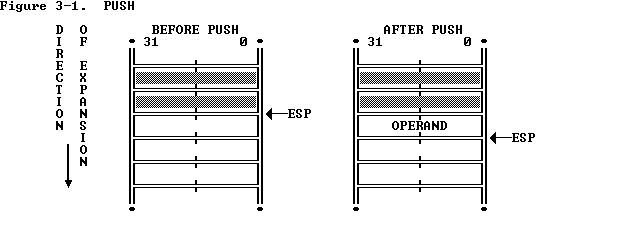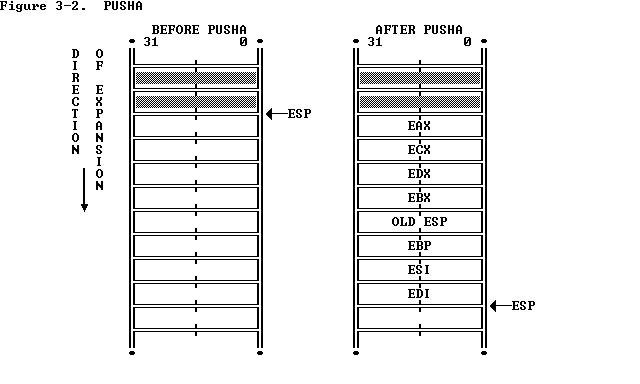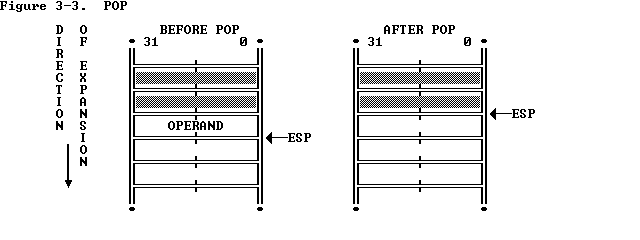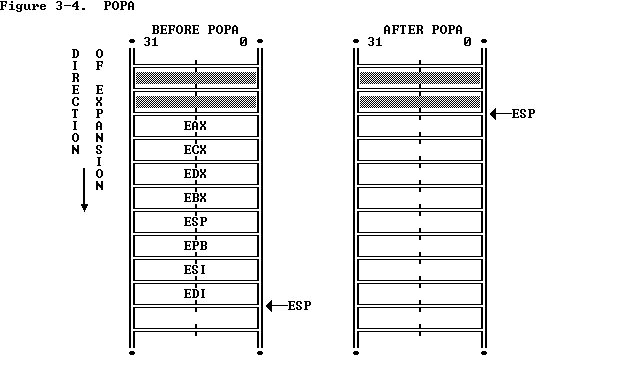up:
Chapter 3 -- Applications Instruction Set
prev:
Chapter 3 -- Applications Instruction Set
next: 3.2 Binary Arithmetic Instructions
3.1 Data Movement Instructions
These instructions provide convenient methods for moving bytes, words, or
doublewords of data between memory and the registers of the base
architecture. They fall into the following classes:
- General-purpose data movement instructions.
- Stack manipulation instructions.
- Type-conversion instructions.
3.1.1 General-Purpose Data Movement Instructions
MOV (Move)
transfers a byte, word, or doubleword from the source operand to
the destination operand. The
MOV instruction is useful for transferring data
along any of these paths
There are also variants of
MOV that operate on segment registers. These
are covered in a later section of this chapter:
- To a register from memory
- To memory from a register
- Between general registers
- Immediate data to a register
- Immediate data to a memory
The MOV instruction
cannot move from memory to memory or from segment
register to segment register are not allowed. Memory-to-memory moves can be
performed, however, by the string move instruction
MOVS.
XCHG
(Exchange) swaps the contents of two operands. This instruction takes
the place of three MOV instructions.
It does not require a temporary
location to save the contents of one operand while load the other is being
loaded.
XCHG
is especially useful for implementing semaphores or similar
data structures for process synchronization.
The XCHG instruction can swap two byte operands,
two word operands, or two
doubleword operands. The operands for the
XCHG instruction may be two
register operands, or a register operand with a memory operand. When used
with a memory operand,
XCHG automatically activates the
LOCK signal. (Refer to
Chapter 11
for more information on the bus lock. )
3.1.2 Stack Manipulation Instructions
PUSH (Push)
decrements the stack pointer (ESP), then transfers the source
operand to the top of stack indicated by ESP (see
Figure 3-1).
PUSH is
often used to place parameters on the stack before calling a procedure; it
is also the basic means of storing temporary variables on the stack. The
PUSH instruction operates on memory operands,
immediate operands, and register operands (including segment registers).
PUSHA (Push All Registers)
saves the contents of the eight general
registers on the stack (see
Figure 3-2). This instruction simplifies
procedure calls by reducing the number of instructions required to retain
the contents of the general registers for use in a procedure. The processor
pushes the general registers on the stack in the following order: EAX, ECX,
EDX, EBX, the initial value of ESP before EAX was pushed, EBP, ESI, and
EDI.
PUSHA is complemented by the
POPA instruction.
POP (Pop)
transfers the word or doubleword at the current top of stack
(indicated by ESP) to the destination operand, and then increments ESP to
point to the new top of stack. See
Figure 3-3.
POP moves information from
the stack to a general register, or to memory
There are also a variant of
POP that operates on segment registers. This
is covered in a later section of this chapter.
POPA (Pop All Registers)
restores the registers saved on the stack by
PUSHA, except that it ignores the saved value of ESP.
See
Figure 3-4.


3.1.3 Type Conversion Instructions
The type conversion instructions convert bytes into words, words into
doublewords, and doublewords into 64-bit items (quad-words). These
instructions are especially useful for converting signed integers, because
they automatically fill the extra bits of the larger item with the value of
the sign bit of the smaller item. This kind of conversion, illustrated by
Figure 3-5, is called sign extension.
There are two classes of type conversion instructions:
- The forms CWD,
CDQ,
CBW, and
CWDE which operate only on data in the EAX register.
- The forms
MOVSX and
MOVZX, which permit one operand to be in any
general register while permitting the other operand to be in memory or
in a register.
CWD (Convert Word to Doubleword) and
CDQ (Convert Doubleword to Quad-Word)
double the size of the source operand.
CWD extends the sign of the
word in register AX throughout register DX.
CDQ extends the sign of the
doubleword in EAX throughout EDX.
CWD can be used to produce a doubleword
dividend from a word before a word division, and
CDQ can be used to produce
a quad-word dividend from a doubleword before doubleword division.
CBW (Convert Byte to Word)
extends the sign of the byte in register AL
throughout AX.
CWDE (Convert Word to Doubleword Extended)
extends the sign of the word in
register AX throughout EAX.
MOVSX (Move with Sign Extension)
sign-extends an 8-bit value to a 16-bit
value and a 8- or 16-bit value to 32-bit value.
MOVZX (Move with Zero Extension)
extends an 8-bit value to a 16-bit value
and an 8- or 16-bit value to 32-bit value by inserting high-order zeros.



up:
Chapter 3 -- Applications Instruction Set
prev:
Chapter 3 -- Applications Instruction Set
next: 3.2 Binary Arithmetic Instructions




